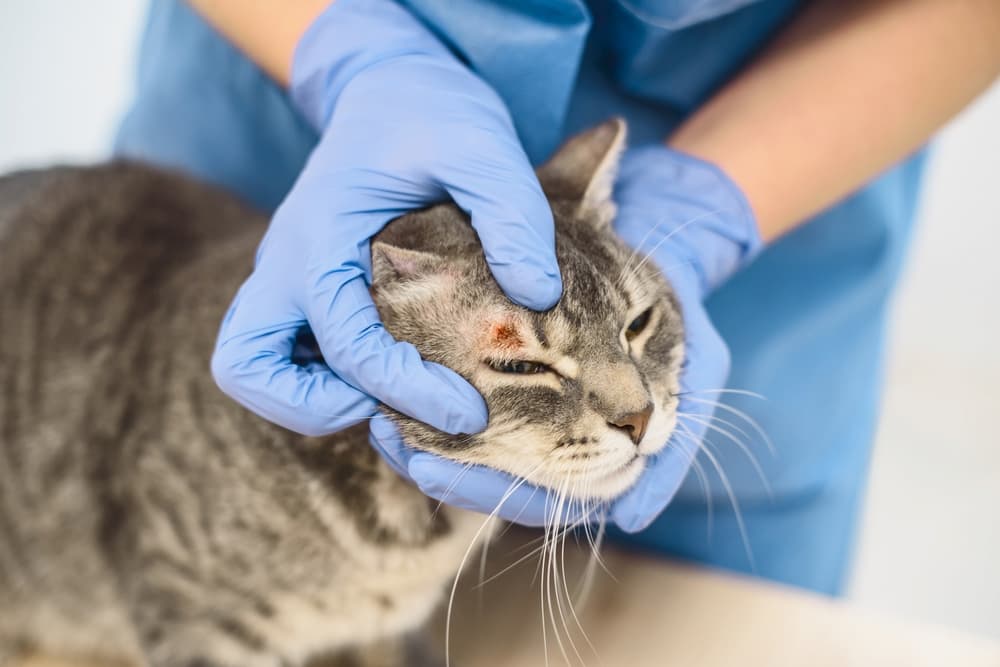7 Symptoms of Allergies in Cats You Shouldn’t Ignore

We aren’t the only ones who suffer from allergies. Our cats do, too!
Allergies are the outward sign of the immune system’s overreaction to an allergen (allergy-causing substance). They are common in cats and can range from mildly irritating to life-threatening.
Learning how to spot cat allergy symptoms in your pet is an essential part of helping ease their discomfort. You’ll need your veterinarian to diagnose what’s causing the allergy and decide on the right treatment. But whether that’s an oral allergy medication like Atopica, a specialized diet, supplements, or parasite prevention, it all starts with knowing what signs of allergy to watch out for.
7 Common Cat Allergy Symptoms

The signs of allergies in cats are variable and can depend on the type of allergy and severity of the allergic reaction. For example, symptoms may appear suddenly when an allergic reaction is severe and immediate or take years to develop after repeated exposures to a particular allergen.
As you read through the list of symptoms of allergies in cats below, be aware that these symptoms do not always automatically point to an allergy. However, it’s worth noting signs of allergies and keeping a record of what you noticed (and when) so you can share that info with your veterinarian.
To make that easier, you can sign up for a free GreatPetCare account so you can keep your cat’s important health details at your fingertips. There’s also a GreatHealthCare app that lets you log symptoms, photos, or questions you want to share with your vet.
Depending on your cat’s symptoms and severity, your vet may need to do some diagnostic detective work to determine whether these signs are due to an allergy or another medical condition.
Here are seven common cat allergy symptoms to look for:
Local or generalized itchiness
Allergies can make cats feel itchy in certain spots or are all over. For example, fleas tend to bite in hard-to-reach areas, like the back of the neck, making a cat feel itchy in that spot. Environmental allergies can cause generalized itchiness.
Hair loss
Allergies can make a cat’s skin very itchy, leading to constant irritation and scratching. This scratching leads to hair breakage and hair loss. Cats with allergies often have patches of hair loss from the itching and scratching.
Red, dry, flaky skin
Along with the itchiness and hair loss, cats with allergies commonly have red, dry, and flaky skin because of the constant skin irritation and discomfort.
Digestive upset
Cats with food allergies can experience digestive symptoms when something they eat upsets their tummy. For example, if a cat is allergic to chicken, eating a chicken-based food may cause symptoms like vomiting and diarrhea.
Itchy, watery eyes
Do you get itchy, watery eyes when there’s a lot of pollen in the air? A cat’s eyes can also become itchy and watery when they’re allergic to something in the environment. Even for strictly indoor cats, dust or strong scents can trigger an allergic reaction that causes itchy, watery eyes. If these symptoms persist, contact a vet as they may also be signs of an eye infection.
Coughing
Cats with allergic bronchitis, also known as asthma, will cough in response to an allergen that irritates their lungs.
Ear infections
Interestingly, food and environmental allergies in cats can lead to ear infections.
Other Symptoms to Watch For
Other symptoms of allergies in cats to watch for include:
- Sneezing
- Itchy ears
- Nasal discharge
- Incessant grooming
- Difficulty breathing*
- Swelling (e.g., lips, paws)
- Conjunctivitis (swollen inner lining of the eyelid)
* Difficulty breathing in cats is a medical emergency. If your cat has trouble breathing, immediately take them to your veterinarian or a veterinary emergency hospital.

Diagnosing Allergies in Cats

Diagnosing a cat allergy can be challenging, time-consuming, and expensive, depending on the type of allergy.
Before going into the diagnostic process, let’s first describe the types of cat allergies:
- Flea allergy: Yes, cats can and do get fleas. Proteins in a flea’s saliva can cause an allergic reaction, making the skin feel very itchy.
- Food allergy: Animal proteins, such as chicken and beef, are common causes of food allergies in cats. Less common food allergens include corn and wheat.
- Atopic dermatitis (environmental allergies): Substances in the environment, like pollen and grasses, can trigger an allergic skin reaction in cats. These allergies are typically seasonal but may occur year-round, especially with indoor allergens like dust and mold.
- Contact allergy: Rarely, substances that your cat contacts, such as shampoo or wool, can cause an allergic skin reaction.
- Cutaneous drug eruptions: Drugs can sometimes trigger an allergic reaction in cats, but this is uncommon.
- Allergic bronchitis (feline asthma): Allergic bronchitis is triggered by substances in the air, such as cigarette smoke or perfume. The allergic reaction causes the airways to become inflamed and constricted, making breathing difficult.
To diagnose an allergy in your cat, your veterinarian will first take a detailed history and conduct a physical exam. The history and physical exam will give your veterinarian the initial clues as to what type of allergy your cat may have.
Your veterinarian will then conduct diagnostic tests specific to the suspected allergy type:
Flea allergy
Diagnosis is usually based on physical exam and history. If fleas are not seen on the cat, a positive response to flea treatment will confirm the diagnosis.
Food allergy
Diagnosing a food allergy requires an 8- to 12-week food elimination trial to identify the food allergen. During the trial, a cat eats only a novel protein diet (a diet containing a protein your cat has never eaten) with no extra treats, human food, or flavored medications. These trials are conducted with veterinary supervision and can be challenging.
Atopic dermatitis
Atopic dermatitis can be diagnosed with a blood test or intradermal skin testing. The blood test looks for levels of antibodies in the blood that are responsible for inciting the immune response to an allergen.
The skin test is the gold standard for diagnosing atopic dermatitis. The veterinarian injects tiny amounts of suspected allergens under the skin and waits for an allergic response to occur (skin swelling) that would identify the allergen.
Contact allergy
Diagnosing a contact allergy can be expensive and time-consuming. The veterinarian applies a tiny patch of potential allergen (e.g., wool) to a cat’s skin. The area with the patch is monitored daily for the next 1 to 2 weeks for an allergic reaction. With so many potential contact allergens, diagnosing contact allergies can be time-consuming and difficult.
Cutaneous drug eruption
Diagnosing a drug allergy relies on knowing the history of medications a cat has recently taken. Symptoms that appeared soon after a particular drug was administered and stopped after the drug was discontinued indicate a drug allergy.
Allergic bronchitis
Chest X-rays are used to diagnose allergic bronchitis.
Treatment for Allergies in Cats

As with allergies in people, allergies in cats are usually managed, not cured. Depending on the type of allergy, your cat may require lifelong allergy management to minimize the risk of future allergic reactions and treat allergy flare-ups.
Flea allergies – The best way to prevent flea allergies is to treat your cat with year-round flea prevention, even for strictly indoor cats. Ask your veterinarian about the best way to protect your cat. Depending on where you live and the parasite risks in your region, they may recommend an oral or topical flea preventative or a combination product that targets fleas, ticks, heartworms and other parasites.



Food allergies – Treating food allergies in cats is simple, but not always easy. To avoid allergic flare-ups, you need to feed your cat a diet free of allergy-inducing ingredients. However, determining those allergens can be challenging. Once your veterinarian identifies the allergen through a food elimination trial, they can recommend a diet to help prevent future allergic reactions. Depending on the type and severity of your cat’s food allergies, that could be a novel protein diet, a limited ingredient diet, or a hydrolyzed diet, in which proteins are broken down (hydrolyzed) into tiny particles that are less likely to trigger an allergic reaction.



Environmental allergies – There are several medications your veterinarian may prescribe to treat atopic dermatitis caused by environmental allergens, including steroids, antihistamines, and immunosuppressive drugs.
While steroids provide rapid itch relief, they can also cause serious side effects. And antihistamines aren’t always effective against allergic itch in cats. That’s why veterinarians often recommend immunosuppressive drugs like Atopica (cyclosporine) to treat non-flea, non-food allergies in cats. Atopica offers the effective itch relief of steroids without the side effects and is generally more reliable than antihistamine treatments. However, it’s important to note that it can take up to 30 days to be maximally effective.

Atopic dermatitis is managed with various medications, including steroids, antihistamines, and immunosuppressive drugs. Steroids provide rapid and effective relief, while antihistamines’ effectiveness is mixed. Immunosuppressive drugs like cyclosporine tamp down the allergic reaction’s intensity but can take up to 30 days to be maximally effective.
Managing contact and drug allergies is relatively straightforward. Avoiding the offending substance or drug is typically sufficient to prevent future allergic reactions.
Allergic bronchitis can be managed with medications to decrease inflammation and relax and open the airways. Cats with severe allergic bronchitis may need to be hospitalized and receive more aggressive treatment.









